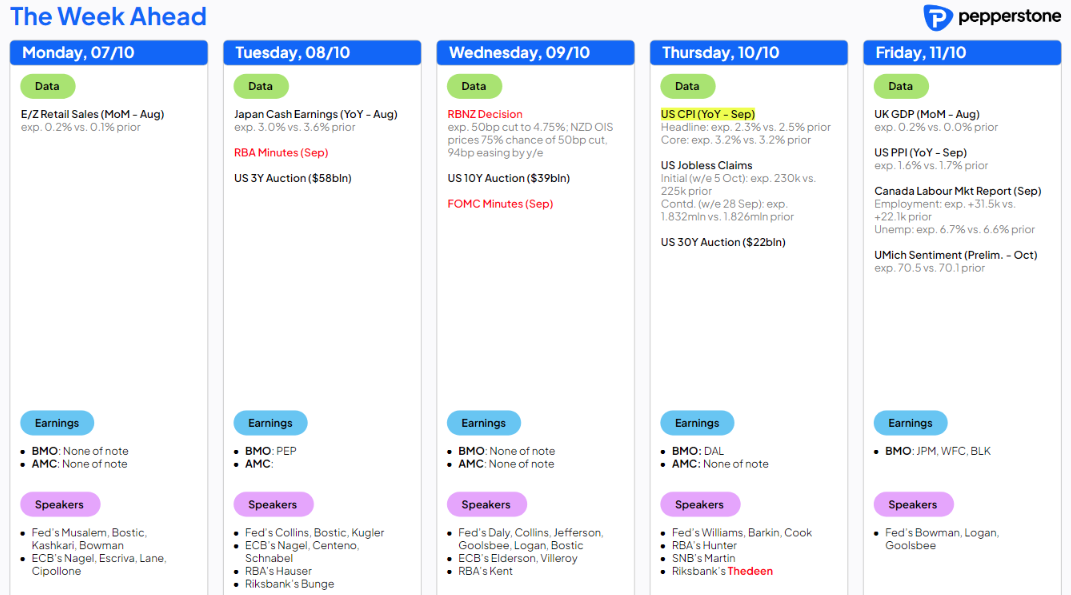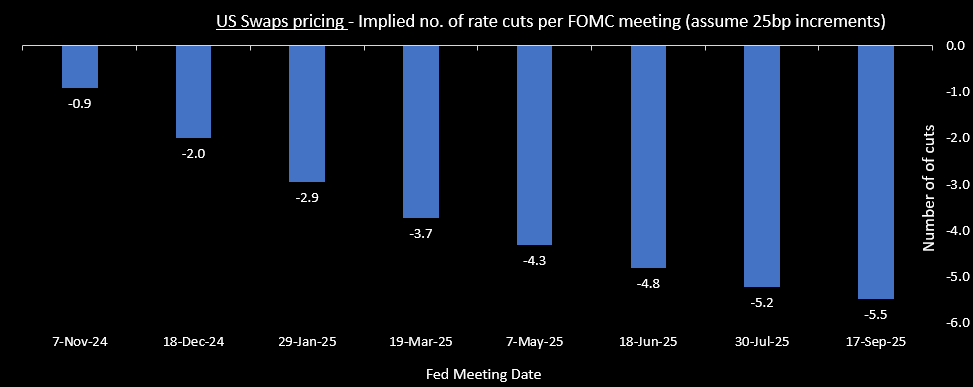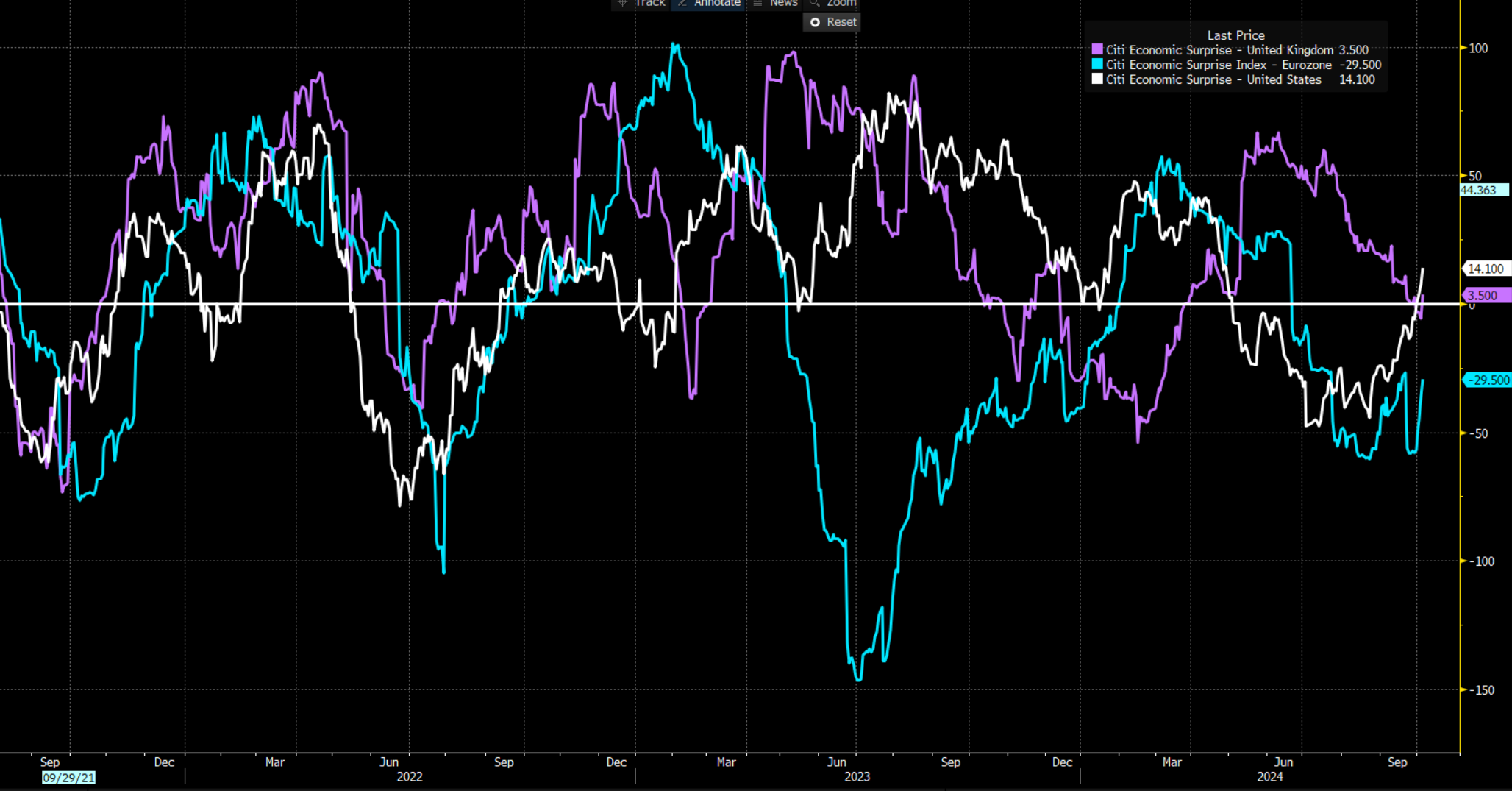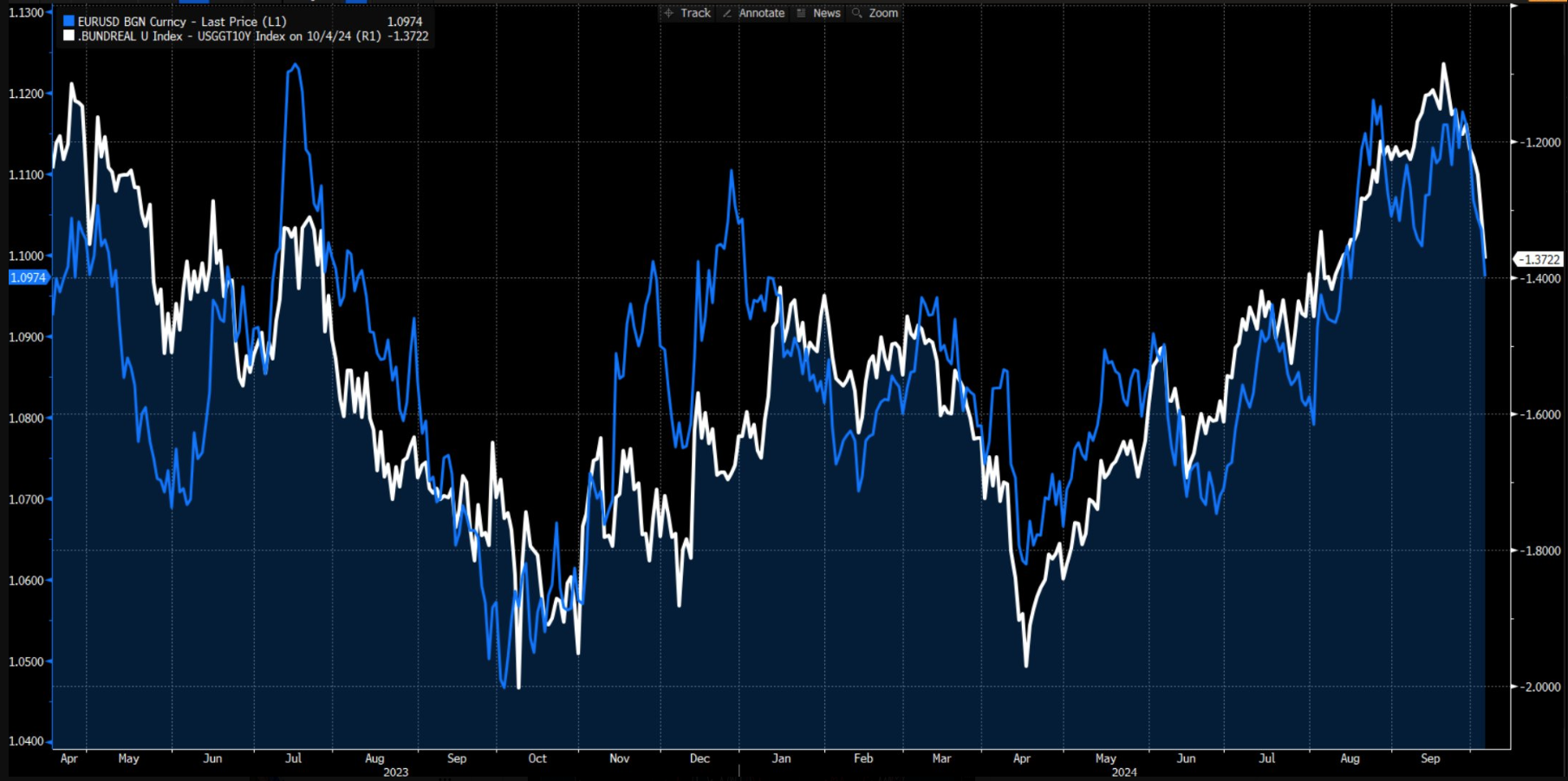Spread bets and CFDs are complex instruments and come with a high risk of losing money rapidly due to leverage. 72% of retail investor accounts lose money when trading spread bets and CFDs with this provider. You should consider whether you understand how spread bets and CFDs work, and whether you can afford to take the high risk of losing your money.
- English (UK)

There was absolutely no ambiguity in the way the market traded the US jobs data - it was solid across all metrics, and remaining US recession calls have once again been pushed out. The more pertinent question is whether the consensus ‘soft landing’ thesis is at risk of becoming a ‘no landing’ scenario.

With the positive turn in the US economic data we saw throughout last week, US interest rate swaps price a more gradualist path to Fed easing, with a conviction 25bp cut expected in both the November and December FOMC meetings. However, with rate cuts still being the default position, and when married to upbeat earnings expectations and China going hard on liquidity and fiscal, the equity bull case and the USD get a shot in the arm.
While geopolitical headlines and the possibility of an energy supply shock remain a continued threat to sentiment, those set long of risk haven’t heard anything significantly market moving through the weekend and head into the new trading week feeling pretty good about the prospect of further upside.
Can US economic exceptionalism be sustained?
The market has seen yet another case study where growing concerns around a sustained deterioration in the US data flow have collided with a series of better key economic data points (JOLTS, ISM Services and NFP). The result has been market players having to rapidly rethink exposures – notably in US Treasuries where yields have teared higher on the week. In turn, the US economic exceptionalism trade has made a comeback, and tactical traders question whether this theme could last into the November US Election, especially if Trump’s odds were to improve.

The Citigroup US economic surprise index has risen to the best levels since April (see chart above), highlighting the trend of US data releases beating economists’ consensus expectations. We can also see the US economic surprise index having the strongest positive trend relative to other major nations' economic surprise indices, and while not yet at levels which really cement a consensus US exceptionalism/long USD position trade, it is certainly adding to the current upside momentum.
US Treasuries driving USD flows
US 2-year Treasuries aligned with the moves in the US surprise index, closing the week with a gain up a sizeable 36bp w/w, with yields eyeing a retest of the 4% level, driven by Fed rate cuts massaged out of the US rates curve. The USD responded hard, having its best week since Sept 2022, with the DXY (USD Index) closing higher on each consecutive day last week. On a broader basis, the USD gained ground vs all G10 currencies, notably vs the JPY, aided by calls that the BoJ (and new PM Ishiba) may be making a policy mistake by flipping to a more dovish stance and backing away from further hikes.
There has been a focus on relative fiscal trends too, with France set to announce its budget as it starts its proposed staggered journey to a 3% deficit of GDP by 2029. A more austere fiscal program in France, Italy, and Spain, will pale in comparison to ever-increasing debt levels in the US, and over time this could prove to be another factor that drives EURUSD lower.

Importantly for the USD, we see US Treasury yields rising sharply on a relative basis to the G10 peers, where yield differentials have been a key factor driving the USD outperformance. Should the US Treasury yield premium continue to increase vs other developed market bonds (e.g. German bunds, UK gilts) then the USD move has legs.
Client flows to trade the USD have ramped up, with the break of 1.1000 in EURUSD getting clear attention, as it has in GBPUSD on the test of the 50-day MA, and USDJPY smashing through 148. The skew in USD directional risk remains towards higher levels this coming week and I see weakness in USDJPY and rallies in EURUSD offering entries to initiate new positions.
US CPI is the marquee data point for the week ahead
In the absence of any tier 1 economic data in Europe, Australia, the UK, and China this week, the focus falls again on the US economic data flow, where the highlight will be September CPI and PPI prints. With the Fed putting far greater emphasis on the labour market and feeling its war on inflation is over (for now), a lower-than-consensus outcome in the US CPI print is unlikely to lift expectations for a 25bp cut in November too greatly, given the barrier to a 50bp cut has been sufficiently lifted.
Conversely, we’d need to see a significant upside surprise relative to the core CPI estimates of 3.2% y/y to have the market really throw doubt about a 25bp cut at the November FOMC meeting.
With some 20 Fed speakers through the week, we should get a guide on how the respective Fed officials see Friday’s NFP print affecting their thought process on policy. One would imagine most should guide to a 25bp cut in November, however, should any hint at a pause in the cutting cycle the USD should continue to follow US Treasury yields higher.
US Q3 earnings start to roll in
The S&P500 closed on its session high on Friday, with longs showing little concern about holding exposures over the weekend and the prospect of gapping risk stemming from Israel/Iranian headlines. New ATHs in the S&P500 are just 15 points away, and as equity traders look towards the start of the Q3 reporting season, with JP Morgan leading us off on Friday, longs will be feeling confident that the bullish momentum in the S&P500, Dow, Russell 2k, and NAS100 holds.
The re-opening of Chinese mainland markets
Having been closed for Golden Week, we also look towards the re-opening of the Chinese mainland equity markets. Despite the CSI300 closed for the period, traders have still been able to chase the incredible upside momentum in the HK50, CN50 and CHINAH indices. It's hard to put into context the rally we’ve seen in these equity indices, as all have undergone multi-standard deviation weekly rallies, and have found strong buying support on the slightest pullback.
On Tuesday (10 am local time), the NDRC will give an update and take questions from the media on potential fiscal policy measures, and given the recent rally in equity, the market will be keen to hear substance that could result in animal spirits, demand and consumption ramping up. In the lead-up, we are seeing upgrades to economists' China 2025 GDP forecasts, and there is a view that China will evolve from being an exporter of deflation to one where they could start to export inflation and become greater support to global GDP. Obviously, that dynamic could be affected by the perception of tariffs, should Trump start to gain traction in the polls.
Staying on the central bank theme, Wednesday’s RBNZ meeting may not get the same level of market attention as the Fed, ECB, or BoE meetings, but with high expectations for an outsized 50bp cut to the cash rate, increased attention on the NZD seems likely. Long AUDNZD has been a big consensus trade with the spot rate rising to 1.1000, and until we see a daily close below the 5-day EMA the trend higher looks robust. Good luck to all.
The material provided here has not been prepared in accordance with legal requirements designed to promote the independence of investment research and as such is considered to be a marketing communication. Whilst it is not subject to any prohibition on dealing ahead of the dissemination of investment research we will not seek to take any advantage before providing it to our clients.
Pepperstone doesn’t represent that the material provided here is accurate, current or complete, and therefore shouldn’t be relied upon as such. The information, whether from a third party or not, isn’t to be considered as a recommendation; or an offer to buy or sell; or the solicitation of an offer to buy or sell any security, financial product or instrument; or to participate in any particular trading strategy. It does not take into account readers’ financial situation or investment objectives. We advise any readers of this content to seek their own advice. Without the approval of Pepperstone, reproduction or redistribution of this information isn’t permitted.
